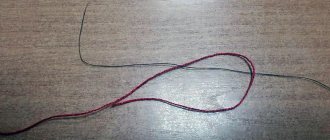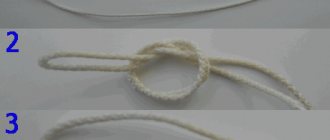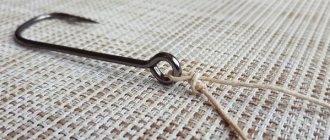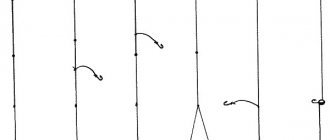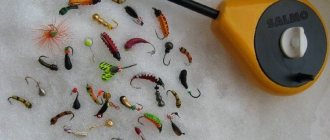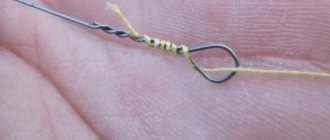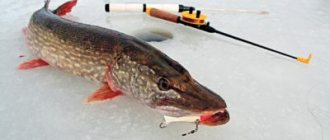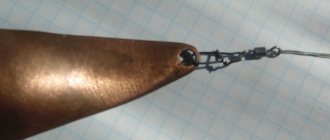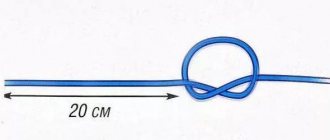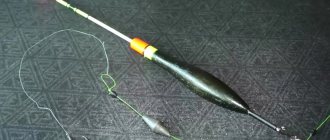Catching a predator with a spinning rod gives the angler true pleasure from the fishing process, filled with excitement, fascination and completely indescribable sensations. However, for fishing to be successful, you need to know some tricks and follow the rules of spinning fishing.
Before you start fishing, you need to study the reservoir and find out its features. But the most important factor for success remains correctly assembled gear. Currently, on the shelves of fishing stores there is a huge assortment of different baits that are used when catching predators. Here you can find both wobblers and poppers, but the most universal bait remains the spinner. In order for fishing to take place, first of all, you need to know how to tie a spoon to a fishing line.
Many fishermen use leashes with a carabiner, on which they attach the lure. This is very convenient in that replacing the bait becomes a matter of a few seconds. But there are situations when the fish is not actively biting, and various foreign objects simply scare away the predator. In this situation, the leash becomes redundant and you have to tie the bait to the fishing line.
Every person who is a fan of fishing has his own secrets and methods in this matter. But there are also methods common to all anglers, which will be described in this article.
Basic methods of attaching a spinner to a fishing line
As mentioned above, there are a huge number of methods used to tie a spoon to a fishing line.
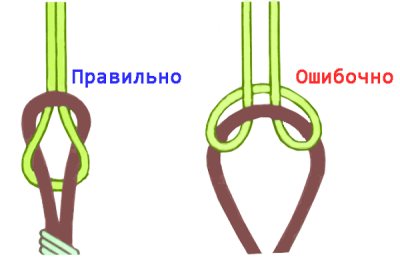
Loop to loop. One of the common methods that has become widespread and has won the hearts of fishermen with its simplicity and strength. This knot is made with several simple manipulations:
- the cord that will be used as fishing line is folded in half and tied with a double knot to form a loop;
- the prepared loops are thrown over each other, and the spoon must be passed through the loop obtained on the fishing line;
- All that remains is to moisten the fishing line with water and tighten the knot very tightly.
a ring located on the base of the spoon is used as the second loop;
This method is very effective, since the loop tightens well and does not weaken the fishing line at all, the strength of which in the place of the formed knot does not decrease in any way.
- thread the end of the fishing thread into the wire ring at the base of the spoon, and leave the working end approximately 15 cm long;
fold it in half and then form a regular loop;
At first glance, it may seem that this is very difficult, but, having gained experience, fishermen tie spoons in this way even in the dark.
- take the end of the fishing line and fold it in half to form a double thread at least 10-15 cm long;
pass it through the bait ring and tie it with the main fishing line with a regular knot;
It turns out to be a triple strong knot, which is very difficult to untie, so you can be completely sure that the spoon will remain in place, even if you catch a trophy specimen when fishing for a predator.
- thread the tip of the fishing thread through the ring of the spoon;
fold the fishing line into a double thread and form a spiral from it;
This knot is very suitable if the angler goes after a trophy pike, since its strength allows it to withstand a very large mass.
- pass the end of the fishing line into the bait ring 2-3 times and form the first loop;
pass the fishing line through the ring one more time to form a second loop;
The ability to tie a spoon is not a decisive factor in fishing, but at the same time it plays an important role. To successfully catch fish with a spinning rod, there is still a lot to learn, but a start has been made, and you can gather a group of friends and go to the pond to hone your acquired skills in practice. Happy fishing!
tvoyarybalka.ru
What knots to tie baits to monofilament fishing line
Since monofilament fishing line significantly loses strength at the knots, to tie the spinner to it, you can use one of the most tensile knots - “ Lindemann ”. To do this, follow these steps:
- We pass the tip of the fishing line into the bait ring and return it back. Forming a loop, we turn the tip again towards the bait ring.
- Pass the tip into the ring again. We get a loop, one side of which consists of two lines.
- We wrap the tip around the double side inside the loop three or five times, the number of turns depends on the thickness of the fishing line, the thinner the line, the more turns.
- Tighten the resulting knot and cut off the tip.
The Lindemann knot is ready.
"Pitzen"
It is worth paying attention to the fact that such a knot can be used to tie the bait with thin and medium fishing line; for thick monofilament, the “ Pitzen ” knot is recommended. In order to tie such a knot, you must perform the following steps:
- We thread the tip of the fishing line into the bait ring.
- We fold the threaded tip parallel to the main part of the fishing line.
- We wrap the tip towards the bait and make three turns around the folded lines. Coils should be made moving in the direction of the bait ring.
- After finishing the turns, we wrap the line again in the opposite direction.
- We pass the tip into the loop from the first turn.
- Tighten the knot and cut the end of the fishing line.
The Pitzen node is ready.
Sea knots are not useful for tying hooks, but they can be useful for tying ropes or thin cords. Check out our beginner's guide to sea knots.
Rod
Fast action spinning rods are best suited for pike fishing . If you have to fish from a boat or covered with bushes and forests, you need to choose among rods with a length of 1.8-2.4 m . These spinning rods are easy to handle when fishing from a boat, and they also make it easy to get through thickets.
If you have to fish from an open shore , it is better to use spinning rods 2.4 or 2.7 , and in some cases 3 m long . This rod will allow you to make long casts, reaching promising points.
The greater the weight of the baits used, the depth and strength of the current test should be . For pike fishing use :
- spinning rods with a dough of about 5-15 g - used mainly for hunting small predators from the shore;
- spinning rods with a dough of about 7-28 g - the most universal, used for both coastal and boat fishing for pike;
- spinning rods, the upper limit of the test range of which exceeds 40 g , are used mainly for fishing on rivers and reservoirs from a boat.
Once a suitable rod has been selected, it needs to be equipped with a reel.
How to make a spinning rod?
Spinning tackle includes a rod to which a reel with fishing line and special equipment or bait are attached. All components must be correctly selected and assembled. Otherwise, there may be problems with the operation of the rod.
Rod
A spinning rod for catching predatory fish must have the following characteristics:
- If fishing will take place from a boat, then the length of the spinning rod should be one and a half meters, and when hunting from the shore - from two to two and a half meters.
- It is better to choose a test load from twelve to fifteen grams. With a small bait weight, the test can be from eight to ten grams.
- In a variety of conditions, you can use a universal rod with a medium action, in which only half of the spinning rod bends.
- A spinning rod with a hard top is much stronger and more durable. However, in order to be able to react to a bite in a timely manner, the rod itself must also be sensitive.
- An important part of the rod is the handle, since it is with it that the fisherman is in contact all the time while fishing. The most convenient and common material for making a handle is considered to be cork. Leather and rubber can be used.
- The service life of the fishing line depends on the guide rings, so they must be reliable and of high quality. The best rings are those made of silicon carbide.
We suggest you familiarize yourself with: The correct fishing line for fishing (winter and summer) on a spinning rod, feeder, float
Coil
Experienced anglers recommend using spinning reels for spinning fishing. There are also multiplier ones on sale, but they lack sensitivity and are short-sighted in casting.
Coil characteristics:
- The case should be metal, not plastic.
- The recommended spool size for a spinning reel is from 2.5 to 3.5 thousand. It is better to choose a medium-sized reel itself.
- The reel movement should be smooth and without squeaks. When purchasing, you need to check this yourself by holding the rod in your hands and checking the smoothness of the move.
- A good reel is characterized by reliable fastening of the bow and a minimum amount of play. In order for the device to serve for a long time, these criteria must also be paid attention to.
- The reel must hold at least fifty meters of fishing line. Otherwise, it will be impossible to make a long cast with its help.
It is best to buy a device from trusted sellers from well-known manufacturers who can guarantee good operation of the coil.
When hunting with a spinning rod, you can use regular monofilament fishing line or braid. Mono lines are mostly soft and elastic, so when using them the bite is not felt very strongly. The fact that the fish is on the hook can be seen by the twitching of the fishing line.
Advantages of monofilament:
- practically does not twist;
- does not form beards;
- fits well on the spool.
When using braided lines, the bite and retrieve are more sensitive. It is recommended to choose hard braids, since they have increased sensitivity of the spinning rod.
Advantages of braid:
- The structure of the cord is stronger than monofilament and fluorocarbon fishing line;
- under heavy loads it does not lose elasticity and does not stretch, which allows the tackle to be used many times;
- has excellent sensitivity to bites;
- Unlike monofilament fishing line, it does not break under heavy loads.
The best diameter for a spinning braided cord is considered to be 0.12–0.15 mm.
Leash
When hunting predatory fish, a leash is mandatory. This is explained by the fact that a pike or other predator can easily cut through the main fishing line with its sharp teeth.
Types of leashes:
- Rigid leashes are made of elastic material and are durable. However, they are noticeable in the water, so you can only use them to catch pike. Hard leashes can be made from guitar string.
- Semi-rigid leashes have different diameters and breaking loads. They are very durable, but have a memory effect. Because of this, such leashes should be changed after becoming entangled.
- Soft leaders are made from fluorocarbon or similar materials. In water they are almost invisible, but the sharp teeth of a predator can bite through them. Therefore, soft leashes are used mainly for catching pike perch, perch, chub, and asp.
Lures
When assembling a spinning rod, a large number of different baits are used.
- Oscillating spinners. The bait consists of metal plates with a bend. Each spoon is equipped with a hook or tee. The thickness of the vibrator can be from 1 to 3 mm. When retrieving, the spinner begins to play, resembling a small fish. This provokes the predator to attack.
- Rotating spinners. The spinners consist of a wire to which a petal and a tee rotating in the water are attached. When cast, such a spoon resembles an insect that has fallen into the water and is swimming or a fish running away. Spinner baits of this type play well even with a uniform slow retrieve. They start playing literally as soon as they get into the water.
- Wobblers. Most often, such baits are made in the form of a fish with one or two tees and a blade in the front. They are divided into several types:
- Sinking wobblers sink to the bottom of the reservoir and retain the horizon only when retrieved.
- Suspenders are lowered to a certain depth. The horizon is maintained both during wiring and after stopping.
- Floating wobblers are in the water before the start of wiring, and then begin to float.
- Silicone baits. Vibrating tails resemble a small fish with a flat tail and are made of silicone. Attached to a jig head or hook. Used for stepwise wiring. Twisters made of silicone or plastic imitate small animals, worms, and insects.
Coil selection
For pike hunting with a spinning rod, spinning reels . They are easy to use, and even a beginner can master the technique of casting and retrieving them. At the same time, inertialess reels allow you to work with equipment of any scale, the main thing is to choose the right reel size .
- 2500-3500 — medium-sized spinning reels, which are most often used in pike fishing with a spinning rod;
- 1000-2000 — such models are suitable for hunting with ultralight and lightweight equipment for small fish on ponds and small rivers, in the coastal zone of lakes, large rivers and reservoirs;
- 4000 and more - reels of this size are used for catching large pike with heavy baits at great depths and strong currents.
You can also use multipliers. These reels are best suited for hunting trophy fish with large bait rigs. They are durable and confidently withstand heavy loads for a long time . Also, thanks to their power, multipliers allow you to catch trophy-sized fish with minimal effort .
Attaching the reel to the spinning rod
The reel is fixed on the spinning rod by means of a reel seat, which is located in the area of the handle. One of its elements is a nut that needs to be tightened. It must be tightened carefully so that the coil is securely fixed.
To the wicker
If your reel is wound with braid, then the knots must match. Since this is a fairly rigid material that has almost zero stretch, it is necessary to attach the spinner to the braid with certain knots. Most often, fishermen use 3 knots for the following purposes:
- Palomar knot.
- Double clinch.
- Rapala.
Palomar
Many fishermen answer the question of how to tie a lure to a fishing line boldly and confidently - with a Palomar knot. It is one of the simplest and most reliable knots that can be tied in just a few seconds. The strength of the connection is quite high, it can withstand loads of up to 10 kilograms. True, when tying such a knot, you have to fold the fishing line, which significantly reduces its length.
A knot can be tied in three simple steps:
- Fold the fishing line in half and pass it through the winding ring on the spoon, then form a regular knot with the main fishing line.
- You should end up with some kind of elongated loop into which you need to stretch the spoon and tighten it.
- All that remains is to trim off the excess fishing line.
Double clinch
The double clinch knot is used by fishermen quite often. High efficiency with a relatively simple tying algorithm gives this connection a noticeable advantage.
The knot is tied in four stages, which any novice angler can handle:
- The first loop is formed by threading the end of the fishing line through the eye of the spoon twice. There is no need to tighten the loop.
- The second loop is formed with 4-6 turns around the main line using the free working end.
- Now all that remains is to thread the working end of the fishing line through both loops, wet it and tighten it.
- Get rid of excess fishing line.
Despite the simplicity of the execution of such a knot, it is in no way inferior in reliability to the Palomar knot, and in some cases even wins - when using short leashes. True, for large spinners with a large diameter of the winding ring and thick braid, such a connection is not suitable.
Rapala
Experienced fishermen prefer to connect the lure to the fishing line with a Rapal knot, which is known to many. It is tied as follows:
- A small distance is left at the end of the fishing line and a loop is formed that does not need to be tightened.
- The free end of the fishing line must be threaded through the eye of the spinner.
- Now pass the working end of the fishing line through the formed loop and return it back.
- Wind 3-4 turns around the main line.
- Now pull the end of the line through the loop a second time, so that you have another loop.
- Now pull the working end through the loop you created in step 5.
- Wet and tighten the knot, then remove excess line.
Winding line
It is important to securely fix the braid on the spool of the spinning reel so that it does not rotate. This can be done in two ways:
- make a noose loop , put it on the spool and glue a small piece of plaster on top;
- place a noose loop on the spool , then pass the fishing line through the fixing clip on the side and reel it in.
As a rule, for spinning it is necessary to use monofilament backing to fill the spool to the end. First, monofilament is wound onto a spool, then a cord is tied to it. After winding is completed, the distance between the braid and the side of the spool should be 1-1.5 mm .
In the case of monofilament, it is enough to tie the fishing line to the spool, make 3-4 turns and tie another knot. After this, the monofilament is securely fixed due to its extensibility. Having wound a sufficient amount of monofilament onto the spool, you need to tie the braid to it .
General rules
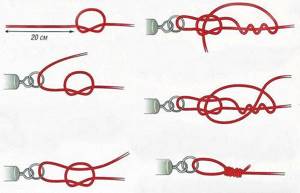
Before talking about how to attach a spinner to a spinning rod, you should establish what it is. Spinner acts as a type of artificial bait for fish. It is formed in the form of metal plates, which are equipped with one or more hooks. Accordingly, the spinner assumes the presence of a hole for tying the bait on the fishing line.
In order not to make a mistake and to equip the means for catching fish correctly, you can refer to the video on YouTube, which offers many lessons on this topic. It will be easier to perceive information visually than following theoretical instructions.
Speaking about the rules that determine how to correctly tie a spinner to a spinning rod, you should pay attention to the knot options that are acceptable in such a situation:
- universal, in which it is enough to thread the fishing line into the eye, then pull it out about ten centimeters, then wrap the shank of the hook, and put the free end into the loop (the knot should be moistened with it before fastening);
- simple, involving threading the fishing line into the eye, after which making about ten turns and forming a loop from the free edge of the fishing line;
- “tight loop”, here you first need to form a simple loose knot, thread the working part into the eye again, tighten it, then re-wrap it with the free part of the fishing line;
- a “blind” loop, which involves forming a simple knot, then threading the working end into the middle of the eye, and then through the original knot, then stretching the end between the curls of the fishing line and tightening.
Knots should be selected based on the possible catch and the nature of the spinning equipment. Some types wear out the fishing line and damage it.
Types of spinning equipment
How best to equip a spinning rod for pike fishing depends on the conditions in which you will be fishing and the mood of the fish. Standard spinning equipment for pike fishing consists of a metal leash to which the bait is attached. This installation is used both for fishing with wobblers, spoons and spinnerbaits, and for jigs.
Also, when equipping a spinning rod for pike fishing, you can use so-called spaced rigs. They are used for fishing with jig baits; their peculiarity is that the sinker is located at a distance from the hook.
- Drop-shot - when making this equipment, the sinker is tied to the end of the main line of the spinning tackle, and the hook is placed directly on it a few tens of centimeters higher. The installation is suitable for fishing for pike vertically, for casting fishing from a boat, bridge or high bank.
- Retractable leash - to assemble such a rig, the sinker must be attached to the end of the main fishing line, and the hook must be attached to the leash, which is tied to it above. A retractable leash is used for hunting passive pike from the shore or from a boat.
- Texas rig - a sliding sinker is placed on a metal leash-twist. This spinning installation device reduces the likelihood of snags to a minimum. The Texas rig is well suited for fishing thickets of grass and snags.
- Carolina rig - a sliding sinker is put on the main fishing line of the spinning rod, then a leash made of monofilament or fluorocarbon is tied to it, at the end of which there is a metal leash. This rig is also used for spinning fishing among grass and snags. The Carolina rig gets caught more often than the Texas rig, but at the same time it provides a more active and lively play of the bait.
Knots for diverting leash
Installation: A pin weight (“stick”, “pear”, “Tyrolean stick”) on a 2 – 30 cm leash made of thick fishing line is tightly attached to the main fishing line. Fastening is possible through a triple (T-shaped) swivel, or using a sliding method (the eye of a conventional swivel slides along the main line). Next, the diverter leash itself is attached through a regular swivel or to the loop of a triple swivel.
Conditions: Fished with a “Moskovskaya” with a long leash in a strong current. It is possible to use both the thinnest lines and light loads, and the most powerful elements, depending on the conditions.
Lures: “twister”, “crustacean”, “slug”, “foam rubber”, equipped with a double hook. It is permissible to equip the rig with a small floating wobbler - “crank” or “minnow”. And also with a small spinner or “turbine”, if the cleanliness of the bottom of the reservoir allows this.
Installation: The “bullet” weight slides along the main line. A simple swivel is tied through a rubber stopper, and a leash with a bait made of flur, mono or leash material is tied to the free eye of the swivel.
Conditions: Fished in moderate and weak currents, in the sea from the shore (“rock fishing”).
Lures. Fishing with massive baits is allowed: “vibrotail”, “ripper”, large “twister” or “worm” (“wacky”). When fishing in a “clean” place, you can install a floating wobbler with the lower tee removed.
Installation: the load is a tightly clamped pellet of the required mass. The leash is knitted “loop to loop” or the main fishing line is used as a leash.
Conditions: “Split-shot” works in weak currents and in still water, in offshore coastal fishing. The tackle turns out to be super sensitive, because... it does not have an additional “retraction” that creates a “braking effect” of the load on the bottom.
Lures: The best baits for Split are twister, slug, crustacean or goose.
QUESTION: how to tie a lead leash to the main line?
ANSWER: It is knitted as follows:
- The main line is made two turns around the index finger of the non-working hand (for a left-handed person - the right, for a right-handed person - the left) hand. In this case, the tension of the fishing line is not strong.
- The resulting turns are carefully removed from the finger and fixed with the fingers of the other hand at the base;
- Above the turns on a thick fishing line, make a 4-6 centimeter simple loop;
- The loop is threaded through the turns;
- Having fixed a thick fishing line near the resulting knot, pull it by the top of the loop and tighten it;
- A leash with a limiting knot (“figure eight”) is threaded into the resulting loop and secured with a suspender to the main fishing line;
If there is a need to use a diverting leash for bait, but you do not know how to properly tie the leash to the fishing line on the spinning rod on the side of the main fishing line, you can try a running knot:
- At one end of the leash there is a hook, previously securely fixed to one of the mentioned nodes. At the other end there is a regular knot.
- In the place where the leash will be attached, the main fishing line forms a loop.
- The end of the leash with the knot is pushed inside the loop, and the second edge is thrown over one of the threads of the fishing line and is also pushed inside the loop on the same side as the end with the knot.
In addition to fishing line for winter fishing for large fish, fishermen often use braided cord. At low temperatures, the fishing line loses its elasticity and often breaks. The high strength of the cord allows it to withstand strong tension and load when fishing for pike or other large fish.
We suggest you read: How to cook hominy for fishing
Bait selection
Most often used for pike fishing:
- spinners;
- oscillating spoons;
- silicone baits;
- wobblers.
Spinning rods are best suited for catching pike with a spinning rod in the coastal zone at shallow depths. They perfectly attract predators of any size. Models axle loading deep areas , including currents. Such fishing, as a rule, takes place from a boat, since rotating spoons have poor flight qualities and it is impossible to cast them far.
Oscillating spoons have remained one of the most popular lures for pike fishing for several decades. They can be used for fishing from the shore and from a boat in shallows, medium and deep depths, selecting models that are suitable in weight. An important advantage of oscillators is that they have excellent flight qualities.
Silicone fish on jig heads or spaced rigs are the best option for fishing in great depths. They are affordable, easy to use and still produce great catches. You can catch pike in the coastal zone with unloaded tires.
Wobblers are universal baits that can be used at shallow, medium and deep depths in currents and in still water, choosing a model that is suitable in size, weight, buoyancy and depth level. But fishing with them requires a certain level of technical skill, so they are not suitable for beginners.
Criterias of choice
Some novice anglers use direct attachment of the bait to the fishing line. But this method takes time when fishing, so they use others. The bait is attached through a carabiner, which is tied to the fishing line.
Rules for attaching baits:
- Non-rotating ones are tied through a swivel. It prevents the tackle from getting tangled;
- A correctly placed knot does not impair the performance of the bait;
- A metal leash is used to catch pike.
Methods for attaching bait to fishing line:
- Straight;
- Through a swivel (carabiner);
- Through the winding ring.
- The most exciting is the simplest. Pass a cord through the hole in the eye of the spinner, run this end 3-4 times around the working line, pull the free end into the loop at the beginning of the bait and tighten. Cut off the unnecessary piece;
- Homer is highly reliable. After threading the thread through the eye of the spoon, make a loop out of it.
Wrap the other end of the main line 5-6 turns, pull it into the initial loop, tighten;
- Grinner is easy to tie. Start by inserting the line into the eye of the spinner, making a simple loop. Make a couple of turns along the working line and pass it into the initial loop. Twist the working thread and tighten;
- Liedemann - more suitable for monofilaments. The fishing line is passed into the upper hole of the spoon 2-3 times, a loop is formed. Then pass it back through the eye, making a double loop. Pull the end of the fishing line through this double loop again and wind 4-5 turns, tighten;
- Clinch is the most common fishing knot. Stretch a thread 10-15 cm into the hole of the bait, fold it in half, and twist the bait around its axis 5-6 times. Now hold the free end near the eyelet and tighten;
- Double clinch – more suitable for braiding. Pull through the top eye 15-20 cm twice, making a double loop. Tie the working end around the main line, pass through the loop, tighten;
- Stevedoring knot - common for spinning lures. Pull the line twice into the upper hole of the bait. Place one end along the main line and make 3-4 turns around it. Then bring it into the formed ring near the eye of the bait and tighten it;
- Figure Eight - used for urgent replacement of baits, it is easy to knit. The thread is folded to form a loop. Use the long end to twist it from above, pull it inward, tighten the connection;
- Albright - used when connecting fishing line and leash, complex in execution. Fold the thread twice, pass the end of the leash through the loop of the fishing line and make 5-7 turns on top of the double fishing line. Make 5 more turns on top of these turns and thread the remaining end into the loop where you first threaded it. Tighten the knot and glue it.
One of the varieties is locking knots. They are used to restrict the movement of floats and loads. Although there are special locking devices, nevertheless, such a knot is convenient to use directly during fishing.
Knitting is simple: a piece of another fishing line, already folded in half, is pressed to the fishing line. With one end, wrap all three threads towards the loop. After 7-10 turns, this end is threaded into a loop and slightly tightened. The knot should move along the main thread with some effort.
How to properly tie a fishing line to a carabiner or a swivel should not bother spinning anglers. The connections are quite simple:
- “Executioner” - the fishing line is pulled into the eye of the carabiner, this end is twisted around this very thread entering the eye. With each turn it must be pulled through the loop. After 5-7 turns, tighten the connection and cut it off;
- “Offshore swivel-knot” - a 10-15 cm loop is pulled into the eye of a swivel or carabiner, while the loop and scaffolding should be directed upward. Turn the carabiner 5-6 times around its axis and tighten.
How to attach a wobbler to a spinning rod - the fisherman must first think carefully. After all, this is an expensive bait.
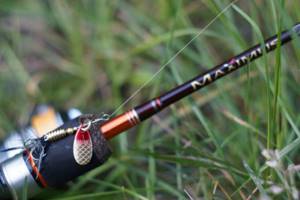
Rapala connection: a knot is tied on the thread at a distance of 20-25 cm from its end. It is pulled into the eye of the wobbler and into the knot on the fishing line. The end is wrapped around the main thread, again pulled into a knot on the fishing line, then smoothly tightened.
But with the bait secured in this way, there is a possibility of losing it. The pike can simply cut the line. Therefore, she should still be tied to a leash. A moving figure eight will do. And if braid is used, then Albright is suitable.
We suggest you read: Mugs for pike - How to make fishing mugs with your own hands
How to properly tie a lure for a fisherman is one of the important issues. An angler, especially a beginner, should be able to knit a dozen different connections. The correct knot is the key to preserving the bait.
The main criteria for choosing spinning tackle are:
- Fishing conditions in the reservoir.
- The predator for which the bait is selected.
- The spinner's fishing style.
When choosing the length and material for gear, the fishing conditions on the reservoir play an important role, since the bottom of the reservoir itself, aquatic vegetation, the presence of flooded trees and snags, and the grass cover of the banks require an appropriate leash length.
For example, for pike, it is necessary to use a strong, medium-length tackle, but for perch, an elastic thread is better, even with low strength indicators in relation to the core of the field cable.
Of course, there are no trifles in fishing. The leash and bait play one of the most important roles here. Choosing them incorrectly can greatly affect the result. So, what circumstances should be taken into account when choosing it?
First of all, let’s decide in what cases is it needed and in what cases is it not? It is generally used for two reasons.
Only a wire leash can save the situation. In any other case, the bait will be lost. Another reason for using it is that when using different baits, it may be convenient to prepare several options in advance, and when fishing, only connect them to the main part of the fishing line.

If you need a leash, then choose it based on your specific situation. Let's consider this issue in more detail.
Fishing conditions
If you are fishing from the shore, which is overgrown with reeds, then casting a spinning rod far will be problematic if both the rod and the leash itself are too large. In addition, an important role in choosing it is played by whether the fishing will take place from a boat, or whether the spinning rod will be cast from the shore.
The nature of the bottom surface and water transparency also influence its choice. For example, for catching pike it is customary to use steel tackle due to the fact that the pike cannot gnaw through it. However, such a choice may lead to the fact that she will be able to see him and the bite will not occur.
Some fishermen consider it justified in such cases to use a more transparent and inconspicuous leash using some inexpensive bait. In this case, there will be a greater chance that the fish will bite and not fall off the hook (even if the bait disappears several times).
Character of the fish
As you know, the behavior of each species of fish has its own characteristics. For example, if you catch pike, you must take into account that this predator has sharp teeth. If the main property is its invisibility, and not strength, then it is more profitable to use a fluorocarbon leader rather than a steel one. Of course, if it exceeds a certain thickness, it becomes noticeable to the fish, and if it is thin enough, then it performs its function perfectly.
Fishing style
Almost everything is important in fishing. We are talking not only about the characteristics of a particular type of fish. Many other factors also matter.
- Time of day.
- Illumination.
- Water transparency.
- The nature of the bottom surface.
- Bottom color.
- Wind strength and direction.
- Food supply for fish at the fishing site.
- Dimensions of the fishing item.
- The degree of its activity.
- And also other factors.
Depending on the specific situation and on the knowledge, experience and luck of the fisherman, its various properties may come to the fore when choosing a leash. Sometimes we are talking about strength, sometimes about softness (so that the game of the bait is not disturbed), sometimes about transparency (so that the fish cannot detect it) or about its other features.
How to properly tie a wobbler to a fishing line
Before throwing a wobbler, you need to tie it correctly to the fishing line. This task is not as simple as it seems. The fact is that some wobblers (especially small ones) are quite finely balanced - and any “extra” element (steel leader and even a rough fastener) can upset the correct balance and worsen the performance of the bait. Fortunately, for most medium and large wobblers this issue is not critical. Although here, too, a rough, heavy leash can interfere with fishing - for example, creating unnecessary sagging of the line during pauses. Therefore, the shorter and lighter the wobbler leash, the better for playing and guiding. But it’s also worth remembering about the size of the prey – so the best option will always be a compromise.
This means that for each wobbler it is advisable to choose its own optimal option for tying to a fishing line.
Methods of attaching bait to equipment
Regardless of whether the fisherman uses a minnow, shad or ratlin class wobbler, the issue of attaching it to the fishing line must be approached with special care. First of all, you need to decide on the key trophies that will be hunted:
- When it comes to catching a small predator that does not have pronounced teeth (perch, trout), the best option is to use a thin metal leash. The thing is that when hunting for this fish, there is a high probability of a pike biting, which will immediately leave the angler without bait. And it is a thin, inconspicuous leash in this situation that can protect the fisherman from a cliff and keep the bait intact. Tungsten, Kevlar, thin guitar string, nichrome, these and many other materials should be considered for use by an angler deciding how to tie a wobbler to catch a small predator. The bait is attached using a miniature fastener for a wobbler or using a twist;
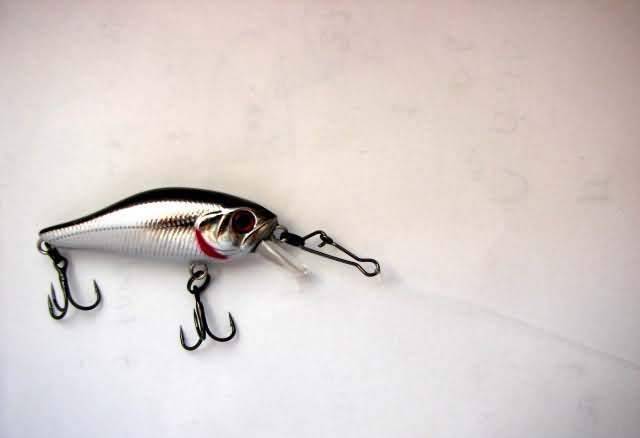
- Catching a “white” predator requires the angler to use special leashes that can not only protect the bait in case of a pike bite, but also have excellent camouflage abilities. We are talking about leashes made of fluorocarbon of a special material, which at first glance resembles ordinary monofilament fishing line. There are a great many differences from it: “flur,” as fishermen call it, is tougher and more durable, and also has much higher abrasive resistance. Thanks to its special structure, this material has a light refractive index close to that of water, and therefore is practically invisible to fish during fishing. To attach the bait to a fluorocarbon leader, you can either use a strong knot, or use a clasp or winding ring;

- Targeted fishing for pike and pike perch almost always involves the use of a metal leash. Naturally, you can also resort to fluorocarbon leashes, but after catching 2-3 fish, such a leash will have to be changed. Classic tungsten or Kevlar leashes, consisting of many wires closely intertwined, have proven themselves best in this situation. This leash is tied using a swivel located in its upper part. And in order to decide how to properly tie a wobbler , you need to resort to the help of a compact fastener located in its lower part.
How to tie a wobbler directly to a fishing line
Manufacturers of wobblers assure that baits must be tied directly to the fishing line with the “correct” knots, and even specially develop them. The latest versions of such nodes are shown in Fig. 1. and are suitable for both monofilament and braid.
Fig.1. Knots for tying wobblers: a) directly behind the eye, b) behind the winding ring.
The manufacturer strongly recommends using a loose loop knot rather than a tightening one, which less restricts the wobbler’s play. For greater clarity, Fig. 2 shows the sequence of knitting a knot-loop from RAPALA:
Fig.2. Sequence of knitting the Rapala loop knot.
Often, for greater mobility, the front eye of the wobbler is immediately equipped with a winding ring, to which the fishing line (mono or braid) is tied with its usual knot. A similar option is to attach via a clasp.
Strong knots used to tie bait or leash to fishing line
The abundance of different options for durable knots known to fishermen today allows you to choose the most optimal option for any situation. The vast majority of anglers use two main types of tying a wobbler, leash or carabiner to the fishing line:
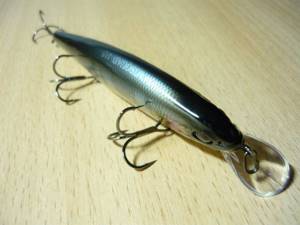
- The traditional method is loop-to-loop. A classic medium-sized loop is knitted on the main line, which is tightened on the winding ring or eye of the wobbler. If it is necessary to replace the bait, the loop is simply loosened, after which the bait is removed from it. The advantage of this method is the natural appearance and adequate behavior of the bait in the water;
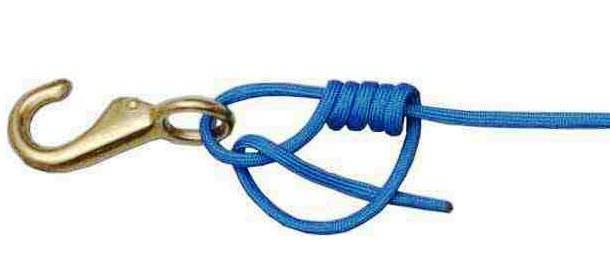
- The clinch knot is both traditional and improved. Using a clinch knot, you can tie both wobblers , which you can buy in our online store, and traditional hooks with a ring, as well as a variety of accessories - winding rings, swivels, clasps, and carabiners. The tip of the fishing line is passed through the ring and makes 5-6 turns around the main fishing line. After this, it is passed first into one formed loop, and then into the second one obtained during the previous operation. After wetting with saliva, the knot is tightened. The bait is tied!
Source: profish.ua
Do you need a leash for a wobbler?
Manufacturers, at best, stubbornly ignore this issue in silence. At worst, they say that the leash is harmful, as it disrupts the “ideal balance” of the bait and its action.
One could agree with this if there were no pike in our reservoirs. It is this very toothy predator that easily cuts both regular and braided fishing lines. And here the question must be posed head-on: a wobbler for pike should initially include a leash.
For example, in every fourth case my small bait ended up entirely in the insatiable mouth. And one day a completely curious thing happened: a 5-centimeter wobbler slipped halfway through the gill slit and hooked the pike from the outside.
Therefore, if you are ready to lose a quarter of your wobblers, and at the same time pikes, then you do not need a leash. I believe that if a “toothy” bite is likely, a leash is a must!
Without a leash, it is justified to catch only asp and chub in a fast current, where there are no pike. In other cases, I personally always use a leash. Without a leash, your record pike hasn't bitten yet, but it's already gone!
Although, indeed, a steel leader changes the balance of a wobbler, especially a small one. In this case, the floating bait may even become sinking. But most medium-sized and all large wobblers allow the use of a “standard” spinning leash with a swivel and fastener without noticeable consequences.
To make the rig easier, you can take the thinnest and shortest (10 cm) leash, you can remove the swivel from it, and if there is already a winding ring in the nose of the wobbler, you can also remove the clasp. Well, for small wobblers you have to use the lightest leash made of special leash material.
If the balance of a wobbler with a leash has changed significantly, you can try to slightly adjust the bait, which will be discussed below.
To the leash
The length and diameter of the leader line directly depends on the size and type of intended prey. The diameter corresponds to the size of the fish, and the length is usually about 60 centimeters. The lure must be tied to the leash with a knot of increased strength, and the leash to the main line with a less strong knot. But the connection must be reliable.
The stevedoring knot is very often used by fishermen when they are faced with the task of how to tie a spoon to a fishing line with a leash:
- The working end of the fishing line must be pulled through the spinner's winding ring twice.
- Now you need to make up to 5 turns around the main line with the working end.
- Now you need to pass the free end through the loop that has formed between the eye of the spinner and the turns.
Eight
The figure eight knot is very often used by fishermen when they are faced with the task of creating a reliable connection that allows them to quickly change bait. But, when fishing for a large predator, such a knot will not be entirely suitable. Although it is very simple to implement and quite popular among fishermen.
The advantages of the knot are the simplicity and speed of knitting. But the knot has only one drawback - low strength. True, some fishermen use high-quality and strong fishing line, which allows them to compensate for all connection errors.
The knot is knitted as follows:
- Fold the fishing line in half, then form a loop out of it.
- Then wrap this loop over the folded line to create a second loop.
- Now insert the second loop into the first.
- Moisten and tighten the knot.
- Remove excess line.
We attach the wobbler to the fishing line through a leash
Of course, theoretically, the leash to some extent disrupts the balance and play of the wobbler. But which one? In each case, you need to look and draw conclusions. In addition, leashes are also different.
Standard leash
Such a flexible leash with a small swivel and a neat clasp is convenient in most cases, which is why it is used most often. The length of the leash depends on both the wobbler and the intended prey - usually 10-20 cm is enough. Pay special attention to the fastener lock - self-unfastening or forgetfulness lead to the unfortunate loss of both bait and fish.
String leash
A wobbler, unlike a spinner spoon, does not twist the line, so a swivel on a leash seems to be not necessary. Therefore, rigid leashes made of thin elastic wire (strings) are often used.
Such a leash may have a blind loop that twists behind a single bait, an unwinding loop and a special clasp. The last two options allow you to quickly change wobblers if necessary. Such lightweight leashes are usually used with small wobblers.
But a rigid leash can also be very useful when jerking a wobbler, when the bait moves in an active zigzag. A semi-soft leash here often gets caught in the hooks, but a hard wire leash - much less often.
rybalkaspinning.ru
What are the methods for attaching a wobbler?
Every self-respecting fisherman who is keen on hunting for predatory representatives of water bodies should imagine how to tie a wobbler without subsequently having problems with its loss. You need to have a clear understanding of when, in what way and with what knot, depending on the material of the main cord, you need to fasten it.
There are a number of ways this manipulation occurs:
- The wobbler can be attached to the main cord through a leash with a clasp or by direct connection to the cord.
- The wobbler can be secured using a winding ring.
Attaching the bait through a leash is useful when fishing exclusively for pike. Her teeth do not spare either fishing line or braid. Here a steel leash is a mandatory precaution. As a rule, steel leashes are sold equipped with a swivel on one side and a metal fastener on the other.
To give the bait greater degrees of freedom, and it is no secret that the leash seriously inhibits the play of all wobblers, it is recommended to remove the swivel and make special demands on the fastener.
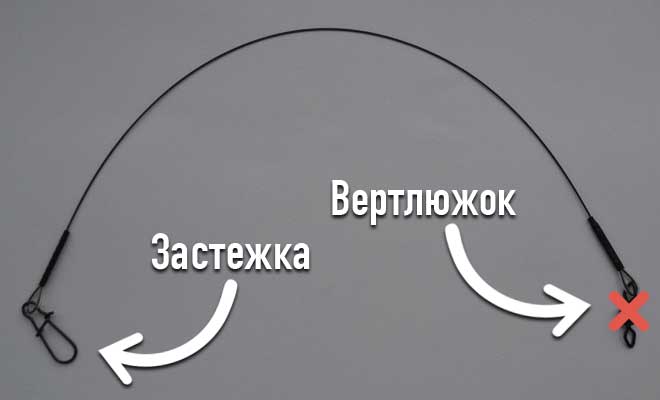
Important! Unlike spoons and especially spinners, wobblers do not twist fishing line or braid. Consequently, the swivel does not provide any useful component in the equipment and can not be used.
The fastener is selected based on the size of the bait. The best option would be a fastener made of strong wire in the form of a hairpin. The fastener is attached directly to the eye, mounted into the body of the wobbler, without any kind of transition elements. The leash itself is tied to the main cord with a blind knot, the types and features of which we will talk about below.
How to properly tie a wobbler directly to the cord, without limiting its movements, can be understood by considering the knots that ensure the formation of a tight loop at the end of the braid or fishing line. Using these features of some nodes, you can tie a wobbler, leaving it all degrees of freedom absolutely without restrictions. As a result of fastening through a tight loop during retrieving, and especially during their pauses, the wobbler for these moments is completely deprived of connection with the rod and cord, showing the maximum of qualities invested in its ability to play by the manufacturer. According to the presented type, baits are knitted for catching fish such as perch, asp, rudd and even pike perch. The absence of a toothy mouth gives confidence in the integrity of the bait and line during the bite.
Important! When the bait is tied directly to a fishing line or braid, its most vivid and expressive game is ensured.
The use of a fastener to attach the bait can be considered only a conditionally direct method of fastening. After all, the fastener during wiring, no matter how miniature it may be, will in any case affect the freedom of operation of the wobblers and limit their capabilities. But many fishermen, omitting this nuance, are happy to use this method of equipment. After all, it is convenient for quickly changing the used artificial fish to another, without wasting time on tying knots and saving the length of the main cord on the edges. If you frequently change bait and retie during one fishing trip, you can lose from one to three meters of the useful length of the cord.
To tie a wobbler, minimizing the restriction of its freedoms and, in addition, avoiding constant tying, you can attach an artificial fish using winding rings. With this method, a winding ring is knitted to the end of the braid or fishing line. The same ring is inserted into the fastening loop of the wobbler; experienced fishermen have probably noticed that some models of wobblers are initially equipped by the manufacturer with this accessory for fastening this type.
The winding ring on the cord is knitted according to the principle of a tight loop. The fish is secured by inserting one ring into another. When the bait is working, the rings do not affect its game, rolling freely over their surfaces, relative to each other, at 360 degrees. The inconvenience is the not very quick change of baits. Although, once you get the hang of it, this manipulation is quite doable within a couple of seconds, and the inconvenience, especially during passive fish activity, pays off with more frequent exits due to the more natural play of the wobbler.
How to tie a leash?
Very often, anglers attach the bait not directly to the main line, but through a leash. Depending on the direction of fishing, this allows you to give the gear the necessary qualities. For example, in ultralight, using thin monofilament or fluorocarbon, you get a more sensitive equipment that is invisible to fish. And when hunting for pike, by tying a steel lead or a piece of thick “flurika”, you can avoid cutting off the bait when fishing for a spotted predator.
If nylon is used as the main line and the leash is also made from it, then experienced fishermen use the Albright knot. It works like this:
- The main thread is folded in half.
- We thread the end of a piece of fishing line intended for a leash into the resulting loop.
- The free end of the future leash, threaded into a loop, is wrapped around the main fishing line folded in half five to ten times.
- After this end is threaded back into the loop, both lines are moistened and smoothly tightened.
This knot allows you to attach not only two pieces of monofilament fishing line. It is suitable for braid and fluorocarbon. It is best to use Albright for threads of similar diameter. If you need to attach a thin leash to a thick main monofilament thread, then the optimal choice would be a clew knot:
- The main scaffold of large diameter is folded in half.
- A thin thread is threaded into the resulting loop.
- Several turns are made around the double main nylon.
- The free end of the future leash is passed under the turns and threaded into the loop.
- All that remains is to smoothly tighten the line and remove the excess ends.
When fishing with an ultra-light rod, a combination of “main braided line + fluorocarbon leader” is often used. In this case, it is better to tie the fishing line using a “Carrot” knot. It's done like this:
- A simple single knot is tied, but not tightened, on one side of a piece of fluorocarbon line.
- The end of the braided fishing line is inserted into the resulting loop.
- Up to a dozen revolutions are made around the “flurik”, and the turns do not lie tightly.
- Then the same number of turns is made back, holding the turns of the braid with your fingers.
- All that remains is to thread the free end of the cord into the loop.
The threads are wetted and tightened smoothly. For reliability, a locking knot can be made at the free end of the fluorocarbon to prevent spontaneous unraveling. A thin leader made from fluorocarbon line can be attached with a shallow or swivel clasp to which you can attach a miniature spinner, a wobble, a wobbler, a micro spinner, and a silicone bait.
There are many more options that allow you to knit together the main fishing line with a leash, but the ones listed above are the most popular and easiest to learn.
Knot theory
Experienced fishermen know that the line breaks before or immediately after the connection. When tying the forest, it stretches and becomes thinner at the base of the bundle. It is not the knots that need to be strengthened, but the segments that become thinner when tightened.
This can be done in several ways:
- Do not tighten the thread completely, or use a self-tightening, movable knot. To do this, a ring-loop is tied on a piece of fishing line, and a ready-made leash with a loop is pulled through it. The end of the thread is put back through it and tightened a little. This knot is the most movable, but it is inconvenient to tie;
- When tying, a piece of thin fishing line is placed under the main thread; after pulling, the pieces are cut off. This method increases strength, but is inconvenient due to its labor intensity;
- Tied in a spiral (the most practical). This way you can attach hooks, fishing line, and make loops.
Knots following the example of a spiral are simple to perform.
Basic rules for attaching bait and knots
- Attaching any bait to is done using a swivel, which prevents the line from twisting;
- Fixed fastening of the bait makes its play poor; knots should be distributed evenly along the entire length of the cord;
- When tying, it is important to prevent the loops from stretching;
- Be sure to wet the nodules.
There are many connections in the fishing world, but experienced anglers use three to five, often not the most reliable ones. The success of fishing depends on the choice of knot

Some manufacturers indicate the types of connections on the packaging of their fishing lines. When tying, you need to make sure that the thread has no visible damage.
How to tie to a fishing line?
For fixing spinners on monofilament fishing line, we can recommend the Grinner knot. This option has the following features:
- The bait has a degree of freedom, which allows it to open up as much as possible when retrieving.
- The strength at the knot does not actually decrease and corresponds to the breaking load of the straight section of the main line.
- Easy to learn, suitable for beginners.
- With some experience and the necessary skills, this option can be knitted within a few seconds.
“Grinner” is most optimal for elastic soft nylon fishing lines. It is not so good with fluorocarbon or rigid monofilaments. It is advisable to replace it with the Rapala knot shown below. The method under consideration is knitted in the following way: 1. The end of the nylon is threaded into the eye of the bait.
2. The thread is folded in half, the optimal length of the double line is up to 15–20 cm.
3. We wrap the thread folded in half with the free end approximately five to seven times.
4. The free end of the monofilament is threaded into the resulting loop.
All that remains is to slowly tighten the thread, after wetting it. The excess end of the monofilament is cut off.
Options for attachment points for spinners
In fishing, various types of bait fixation units are used, the progenitors of which are:
- Universal node.
- Simple knot.
- Tight loop.
- Knot with a “blind” loop.
Universal knot

Based on the use of monofilament and braid. Its peculiarity lies in its effectiveness in hooking fish during hooking.
The following stages of node formation are distinguished:
- Thread the line through the eye of the hook.
- Pull the end of the fishing line 10 cm from the eye and form a loop.
- Wrap the end of the fishing line around the shank of the hook 5–7 turns.
- Thread the previously prepared loop with the free end of the fishing line.
- Be sure to wet the knot before tightening it by stretching the line into two opposite ends.
Simple knot

A simple knot is somewhat better than a universal one, since when tying it, the probability of deformation of the fishing line, at which it loses its strength, is minimal.
However, not all types of fishing line are suitable for a simple knot, the formation principle of which is as follows:
- Thread the line through the eye of the hook.
- Twist it 8–10 turns around the hook (both ends of the fishing line are held by hand).
- Form a loop from the free tip of the fishing line at the eye.
- Thread the other end of the fishing line into the above loop.
Tight loop knot
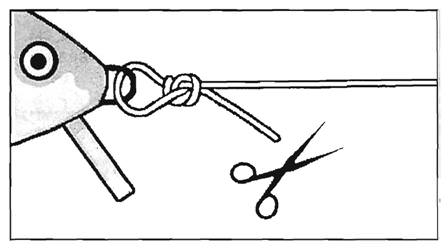
The “tight loop” knot is designed for free movement of the bait in the water column.
Its knitting consists of the following stages:
- Thread the fishing line into the eye of the bait, extending the end by 12-15 cm and form a simple knot, without tightening it.
- Thread the working end of the fishing line into the eye of the bait again and, at the exit, through a simple knot on the main fishing line, tightening it.
- Wrap the main line again with the free end, making another simple knot, tightening it, and trim off the excess line.
Advice: the more active the spinner’s “play” (wide range of movements), the more productive the fishing.
Knot with a “blind” loop
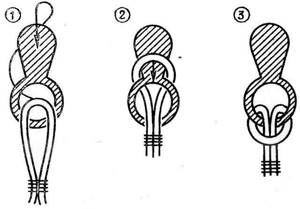
A knot with a “blind” loop, just like the previous one, ensures a soft “game” of the bait. The disadvantage is the use of a fishing line with a dense structure due to the tightness of the knot, which significantly undermines the strength of the thin threads of the fishing line.
Algorithm for creating a node:
- Pull the free end of the fishing line through the eye of the bait, first forming a simple loose knot.
- We pass the working end, 10-12 cm long, through the middle of the formed knot, bringing the end above the main fishing line.
- Again we pass the working end of the fishing line through the original knot, slightly pulling it.
- Place the working end into the lower gap between the curls of the fishing line and tighten the knot, after wetting it.
How to increase your fish catch? ">
Over 7 years of active fishing, I have found dozens of ways to improve the bite. Here are the most effective ones:
- Bite activator . This pheromone additive attracts fish most strongly in cold and warm water. Discussion of the bite activator “Hungry Fish”.
- Increased gear sensitivity. Read the appropriate manuals for your specific type of gear.
- Pheromone -based lures .
How to tie to a cord?
Attaching the spinner to a braided thread can be done using two main knots - “Clinch” and “Palomar”. The first is somewhat more complicated, but is considered more reliable. The second one is easy to knit, but reduces the strength of the tackle. Let's consider a simple option that can be recommended for beginning spinning players. You can secure the bait using the Palomar knot as follows:
- A piece of cord folded in half is threaded halfway through the loop of the bait, clasp, eye of a swivel or leash. The length of the folded section is 15–25 cm, depending on the size of the spoon.
- A single knot is made, which is not completely tightened.
- The bait is threaded into the resulting loop.
- The braid tightens.
All that remains is to cut off the extra piece of fishing line. That's it, Palomar is ready.
Wobbler binding
Another bait option is a wobbler. This type of artificial catch attraction is a solid and fairly voluminous bait, which is more suitable for spinning rods. Intended in most cases to catch predatory fish, however, in practice it often occurs regardless of what kind of fish should be caught.
When using a wobbler, you should use a steel leash, however, situations are allowed in which such a bait can be connected directly to the fishing line (catching pike, trout).
The procedure for tying a wobbler to a fishing line will be determined by the following procedure, which allows you to keep the fishing rod in proper condition throughout the entire fishing trip:
- First, you should take a fishing line and make a simple knot at one of the ends, maintaining a distance of fifteen centimeters.
- Use fishing line, cord or nylon. The free end of these elements must be threaded into the hole, which is located directly on the bait, that is, the wobbler.
- Next, the thread passes into the loop of the first simple weave, which is a single version of the knot.
- Below the formed loop, you should make several turns (at least five).
- The remaining end of the thread is threaded into the loop, be sure to wet it and tighten it to secure the result.
This type of action is considered universal, since this way you can tie any type of wobbler, regardless of what kind of fish you plan to catch.
Thus, there are many options for using artificial bait and then tying it directly to a cord or fishing line. Fishing also provides several types of means to attract fish: wobblers, spoons, and so on. Each type will provide for separate fastening rules, types of nodes and procedures.
Source: orybalke.com
Fluorocarbon leash for pike fishing
Due to the special structure of its teeth, pike easily bite through fishing line. Catching pike with a tackle without a leash is completely impractical, since it is almost impossible to remove it without losing the bait due to a bite.
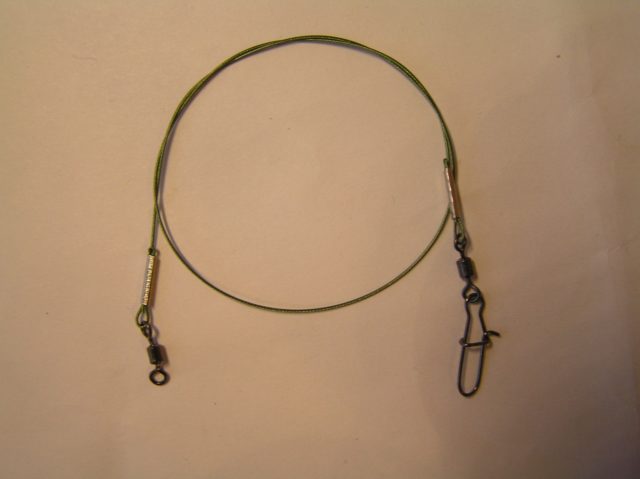
Line – 100% fluorocarbon is more rigid and wear-resistant than regular line
Various materials can be used for pike leashes:
- steel or copper wire;
- tungsten and titanium;
- Kevlar;
- a pigtail made of double fishing line of large diameter;
- fluorocarbon.
The fluorocarbon leash, due to the high technical characteristics of the material, has gained popularity in catching this predator. The use of a fluorocarbon leash on pike is justified in cases where the predator is inactive and is not caught on gear equipped with metal leashes. The optimal thickness of a fluorocarbon leader for pike fishing is at least 0.4 mm.
Buoyancy and leash
When installing a wobbler on a spinning rod, we take into account the change in buoyancy of the bait with a metal leash. On large minnows this is not critical - buoyancy remains almost unchanged. However, on small minnows and cranks, the suspender can turn into a sinking one, and a floating one into a slowly floating one.
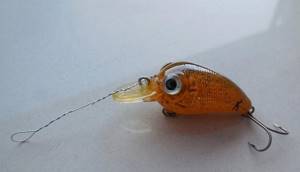
To properly equip a spinning rod with a small wobbler, this needs to be thought through. The weight of the load can be adjusted using an interchangeable set of measures:
- Try leashes of different lengths and thicknesses, and therefore weights.
- Try removing or installing a winding ring, swivel or knotless hook on the other end of the twist.
- Change the tees to lighter ones, as well as the rings on them.
If all else fails, for example, the suspender begins to sink and this is unacceptable - we tie a piece of fluorocarbon to the cord with a carrot, and tie it to the wobbler with a rapala knot without any accessories - this is the lightest option in terms of weight. The only easier way is to directly tie the cord to the wobbler - but here there is a high probability of the pike cutting off the bait.
Subscribe to the channel:
YouTube channel RYBAFAN
String twist
Pike are present almost everywhere in our reservoirs. Even when hunting chub with small surface cranks, it is likely that he will take a pencil and cut the braid. Therefore, in our conditions, it is advisable to use metal leashes with wobblers. Except for rare cases when the pike in this particular place definitely does not take. To the question of which leashes are best for wobblers in our conditions, there is only one answer - a twisted metal string in most cases. Firstly, it protects the cord from pike teeth. Secondly, the rigidity of the string prevents the tee from overlapping the fishing line.
Wobblers are expensive baits, and their loss is costly. However, if the weight of the leader has almost no effect on the performance of large wobblers for pike, then on small ones it can significantly change the buoyancy. A floating microcrank or small minnow can turn into a sinking one - here we are already working on the issue of loading.
READ ✅ Wobblers kosadaka reviews
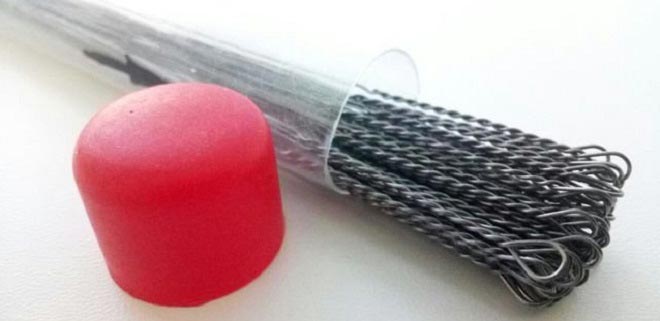
Factory ring
The winding ring is removed when using the leash - in this case, this element of the fittings becomes an extra link in the equipment. The ring is left if the wobbler is tied with a blind knot to braiding or fluor – to maintain mobility. It should be left if the bait ring is placed deep in the recess of the blade (on some models), and it is difficult to attach a leash to it, since the twist or carabiner does not fit into it because of this.
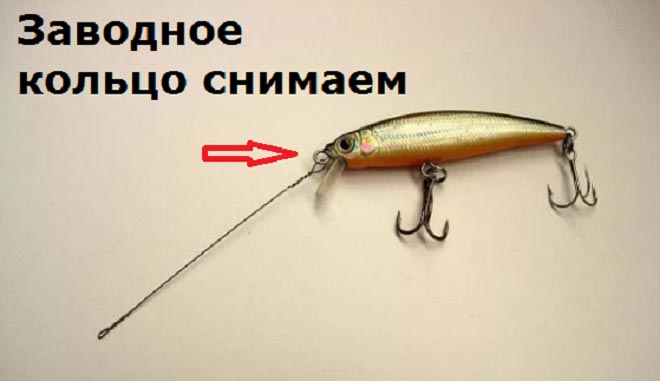
Twist
The string leash for wobblers is made of stainless steel wire or string with a diameter of 0.28-0.4 mm. The thicker and longer, the heavier. On large pike and large minnows you can use powerful and long twists, up to 30 cm long. With small baits we select them so that the leash does not change its buoyancy much. By selecting the weight of the leash, leaving or removing the winding ring, knotless, swivel at the other end, we achieve the desired buoyancy.
